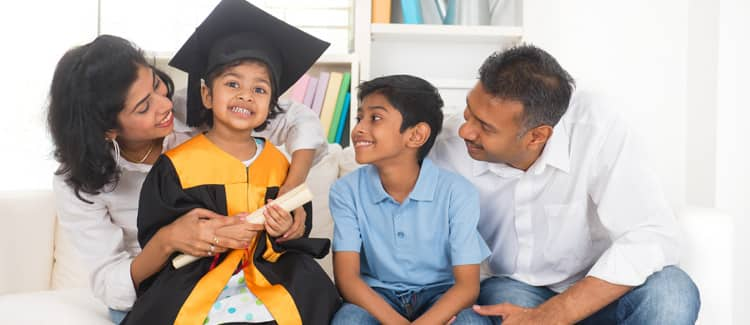Government Child Education Plan
Government child education plans include a range of initiatives and programs that aim to ensure access to quality education for all children. These schemes address various aspects of child education, including enrolment, retention, and the overall quality of schooling.
Read more
Invest ₹10k/month your child will get ₹1 Cr# Tax-Free*
-
Home

-
Child Plans

- Government Child Education Plan
Here, we will discuss the major government schemes for child education in India.
Key Features of Government Schemes for Child Education
The key features of government child education plans in India are listed below:
-
Universal Access: The government schemes aim to ensure that every child, regardless of socio-economic status or background, has access to primary and secondary education.
-
Scholarships and Financial Assistance: Government schemes often include scholarships and financial aid programs to support underprivileged children in continuing their education, especially at higher levels.
-
Girl Child Education Promotion: Many government schemes for girl child education provide incentives, scholarships, and safety measures to increase the enrolment and retention of female students.
-
Infrastructure Development: Government schemes for child education also invest in building and upgrading school infrastructure, including classrooms, libraries, laboratories, and sanitation facilities. This aims to create a conducive learning environment.
-
Quality Enhancement: Some government child education plans emphasize on improving the quality of education through teacher training, curriculum development, and the provision of learning materials.
-
Inclusive Education: Efforts are made to ensure that children with disabilities or special needs have equal access to education through inclusive schooling and support services.
-
Skill Development and Vocational Training: Some schemes offer skill development and vocational training programs to prepare children for employment opportunities and reduce dropout rates.
-
Digital Learning Initiatives: In the modern age, many schemes incorporate technology-enabled learning, such as providing tablets or internet access to students to enhance their learning experiences.
List of Government Child Education Plans
-
Sarva Shiksha Abhiyan (SSA)
-
Rashtriya Madhyamik Shiksha Abhiyan (RMSA)
-
Mid-Day Meal Scheme
-
Beti Bachao Beti Padhao (BBBP)
-
Sukanya Samriddhi Yojana (SSY Scheme)
-
Balika Samriddhi Yojana
-
Ladli Scheme
Details of Best Government Child Education Plan~
-
Sarva Shiksha Abhiyan (SSA)
Sarva Shiksha Abhiyan (SSA) is a flagship program of the Government of India that aims to provide universal access to elementary education. It was launched in 2001-02 and is implemented in partnership with state governments and local self-governments.
Key Objectives of Sarva Shiksha Abhiyan (SSA):
-
Provide access to quality elementary education for all children in the 6-14 age group
-
Bridge gender and social gaps in education
-
Enhance learning levels for all children
Features of Sarva Shiksha Abhiyan:
-
Universal Access: SSA aims to provide access to elementary education for all children in the 6-14 age group, regardless of their socio-economic background, gender, or location.
-
Quality Education: SSA, as the best government child education plan, emphasizes the delivery of high-quality education. This includes providing support for teacher training, developing curriculum materials, and improving infrastructure in schools.
-
Equity and Inclusion: SSA is a government scheme for children that pays special attention to underprivileged children by providing scholarships, establishing residential schools, and offering other forms of support.
-
Partnership with State Governments and Local Self-Governments: SSA is implemented in partnership with state governments and local self-governments. This ensures that SSA programs are aligned with the priorities of the state and local governments.
-
Focus on Learning Outcomes: This government child education plan emphasizes the importance of learning outcomes. This is reflected in the focus on providing quality textbooks and other teaching materials and on training teachers in effective teaching methods.
-
-
Rashtriya Madhyamik Shiksha Abhiyan (RMSA)
Rashtriya Madhyamik Shiksha Abhiyan (RMSA) is a centrally sponsored scheme of the Government of India that aims to improve the quality of secondary education in India. It was launched in March 2009 and is implemented by the Ministry of Education.
Key Objectives of Rashtriya Madhyamik Shiksha Abhiyan (RMSA):
-
Provide access to quality secondary education for all children in the 14-18 age group
-
Bridge gender and social gaps in secondary education
-
Enhance learning levels for all students
Features of Rashtriya Madhyamik Shiksha Abhiyan (RMSA):
-
Access and Equity: RMSA is a government child education plan that aims to provide universal access to secondary education, regardless of the socio-economic background, gender, or disability of the student.
-
Quality Improvement: RMSA aims to improve the quality of secondary education by making all secondary schools provide adequate infrastructure, qualified teachers, and relevant curriculum.
-
ICT Integration: RMSA promotes the use of information and communication technologies (ICT) in secondary education. This includes providing computer labs in schools and training teachers on how to use ICT in the classroom.
-
Education for Children with Disabilities: RMSA promotes inclusive education for children with disabilities. This includes providing special schools and classes for children with disabilities, as well as training for teachers on how to teach children with disabilities.
-
Education for Students from Disadvantaged Backgrounds: Rashtriya Madhyamik Shiksha Abhiyan also provides support to students from disadvantaged backgrounds, such as students from rural areas, scheduled castes, and scheduled tribes. This includes providing scholarships, hostel facilities, and other support to help these students succeed in secondary school.
-
-
Mid-Day Meal Scheme
The Mid-Day Meal Scheme (MDMS), also known as Pradhan Mantri Poshan Shakti Nirman (PM POSHAN), is a school meal programme in India designed to improve the nutritional standing of school-age children nationwide. Th is government child education plan was launched in 1995 as the National Programme of Nutritional Support to Primary Education (NP-NSPE) and was renamed to MDMS in 2007. In September 2021, the scheme was further renamed to PM POSHAN.
Key Objectives of Mid-Day Meal Scheme:
-
Improve the nutritional status of children studying in government schools, government-aided schools, Education Guarantee Scheme (EGS) centres, Alternative and Innovative Education (AIE) centres and locally funded schools
-
Motivate children coming from socioeconomically weak backgrounds to attend school regularly and help them focus on classroom activities.
-
Reduce the incidence of classroom hunger and malnutrition.
-
Improve the social cohesion and promote gender equality.
Features of Mid-Day Meal Scheme:
-
Universal Coverage: This is a government child education plans that covers all children enrolled in government and government-aided primary and upper primary schools, as well as government-aided Anganwadis, Madarsas, and Maqtabs.
-
Free Cooked Meals: The scheme provides free, hot-cooked lunches to children on all working days of the school year.
-
Nutritional Balance: The meals provided under the scheme are nutritionally balanced and meet the recommended dietary allowances for children.
-
Decentralized Implementation: The scheme is implemented by the state governments and union territories with financial and technical support from the central government.
-
Community Participation: The scheme involves community participation at the school level through school management committees.
Investment
Secure
Secure your child’s future with or without youStart Investing₹10,000/Month& Get₹1 Crore**Standard T & C Apply -
-
Beti Bachao Beti Padhao
The literal translation of the scheme is "Save the Girl Child, Educate the Girl Child." Beti Bachao Beti Padhao (BBBP) is a flagship program of the Government of India that aims to address the declining Child Sex Ratio, child marriage, and gender inequality. The aim of this government child education plan is to promote the safety of girl children before and after they are born. It believes in creating a quality education system for girl children and empowering women.
Key Objectives of Beti Bachao Beti Padhao (BBBP):
-
Improve the Child Sex Ratio in India.
-
Ensure the survival, protection, and education of the girl child.
-
Prevent gender-based discrimination and violence.
-
Empower girls and women.
Features of Beti Bachao Beti Padhao (BBBP):
-
Multi-Sectoral Approach: The BBBP scheme is implemented through a multi-sectoral approach involving various government ministries, departments, and agencies, as well as civil society organizations.
-
Strict Enforcement of the Pre-Conception and Pre-Natal Diagnostic Techniques (PCPNDT) Act: The PCPNDT Act prohibits sex-selective abortions. The BBBP scheme has taken steps to strictly enforce this Act, such as by setting up special courts and by increasing the penalties for violations.
-
Promotion of the Sukanya Samriddhi Yojana (SSY): The Sukanya Samriddhi Yojana (SSY) is a government child education plan for girl children. The BBBP scheme has promoted the SSY to encourage parents to save for their daughters' future.
-
Focus on High-Risk Districts: The Beti Bachao Beti Padhao scheme initially focused on 100 districts with low Child Sex Ratios. These districts were identified based on the 2011 Census data. The scheme has since been expanded to cover all districts in India.
-
Emphasis on Community Engagement: The scheme emphasizes community engagement to change social mindsets and attitudes towards girls and women.
-
-
Sukanya Samriddhi Yojana
Sukanya Samriddhi Yojana was launched by the Government of India in 2015 under the Beti Bachao Beti Padhao campaign. It aims to address the issue of the declining Child Sex Ratio and encourage parents to empower their daughters and save for their future. It is a central government child education plan that is jointly operated by various ministries of the Government of India.
The Sukanya Samriddhi Yojana specifically focuses on the girl child and is designed as a small savings scheme that can be used towards the welfare of the girl child, such as higher education and wedding-related expenses.
Key Objectives of Sukanya Samriddhi Yojana (SSY Scheme):
-
To encourage parents to save for their daughters' future.
-
To empower girls by providing them with financial security.
-
To promote gender equality.
Features of Sukanya Samriddhi Yojana (SSY Scheme):
-
Opening an Account: The Sukanya Samriddhi Yojana account (SSA) can be opened in the girl child's name any time before the girl child attains 10 years of age.
-
Initial Investment and Contributions: The first investment can be a minimum of Rs. 250, and the subsequent investments are to be made in multiples of Rs. 50, subject to a maximum annual investment limit of Rs. 1.5 lakhs.
-
SSY Interest Rate: The current interest rate provided by the SSA account is 8% p.a.
-
Tax-Benefits: Investments made in the SSY scheme are eligible for deduction under Section 80C of the Income Tax Act, 1961. The interest earned and maturity proceeds from this investment plan are also tax-free.
-
Investment Period and Maturity: The contribution process in this best investment option goes on for 15 years, and the account matures after a maximum period of 21 years from opening the Sukanya Samriddhi Account (SSA).
-
Account Operation: The parent or legal guardian can operate the Sukanya Samriddhi Yojana account (SSA) on behalf of the girl child until she is 10 years old. Post this age, the girl child may operate the account on her own.
-
For Multiple Daughters: The parents or legal guardian can open an account for a maximum of two girl children, including an adopted girl child.
-
-
Balika Samriddhi Yojana
Balika Samriddhi Yojana is another government scheme to support a girl child in financially backward strata of society. This scheme aims to enrol and retain girls in schools. This government child education plan was launched in 1997 by the Ministry of Women and Child Development, Government of India.
Key Objectives of Balika Samriddhi Yojana:
-
To encourage parents to save for their daughters' education and to empower girls.
-
To improve the status of the girl child in society.
-
To remove gender inequality.
Features of Balika Samriddhi Yojana:
-
Financial Inclusion for Girls: Balika Samriddhi Yojana aims to promote financial inclusion for girls.
-
Birth Registration Incentives: Parents are encouraged to register the birth of their girl child and receive incentives.
-
Safe and Secure Future: This government child education plan paves the way for a secure and prosperous future for girls.
-
Breakdown of Gender Bias: Balika Samriddhi Yojana works towards breaking down gender biases and fostering equality.
-
Encouragement for Education: The scheme encourages families to prioritize the education of their girl child.
-
Cash Incentives: Girls receive cash incentives for completing specific milestones like education and health check-ups.
-
Boosting Financial Independence: The government scheme for child education supports girls in becoming financially independent and empowered.
-
-
Ladli Scheme
The Government of Haryana launched this scheme under the state's Ministry of Child and Women's Development. The Ladli Scheme was also launched to break the stigma about the birth of a girl child.
This state government child education plan aims to spread awareness about protecting girl children, improve the sex ratio of the state, and provide good educational facilities for females across the state.
Key Objectives of Ladli Scheme:
-
Improve the sex ratio at birth and ensure the survival, protection, and education of the girl child.
-
Prevent gender-based discrimination and violence.
-
Empower girls and women.
Features of Ladli Scheme:
-
Financial assistance: The Ladli Scheme provides financial assistance to the families of girl children in the form of cash deposits or investments in savings schemes. The amount of assistance varies from state to state but typically ranges from Rs. 5,000 to Rs. 1 lakh per child.
-
Education: The Ladli Scheme encourages the education of girl children by providing financial assistance for their school fees, uniforms, and other educational expenses. This government child education plan also provides incentives for girls to complete their primary and secondary education.
-
Health: The Ladli Scheme also provides financial assistance for the healthcare of girl children, including immunization, vaccination, and other medical expenses.
-
Marriage: Some states that have adopted the Ladli Scheme also provide financial assistance for the marriage of girl children. This is to discourage child marriage and to ensure that girls have a secure future.
-
People also read: Sukanya Samriddhi Yojana Calculator
Documents Required for the Government Child Education Plans
Individuals wishing to invest in the above mentioned Best Government schemes for child education need to submit the following documents:
-
ID proof: A photo identity card such as an Aadhar Card, PAN Card, voter ID card, passport, driver's license, or NREGA-issued job card.
-
Address Proof: Documents proving the residential address such as voter ID card, Aadhar Card, passport, driver's license, or NREGA-issued job card
-
Age Proof of Girl Child: A birth certificate that is considered the primary document for establishing the age of a child.
-
Photographs: Passport-sized photographs of the parent or legal guardian and the girl child have to be submitted along with the account opening form.
-
Domicile Certificate: This certificate is required to prove that the girl child is a resident of the state in which the scheme is being implemented.
-
Birth Certificate: This certificate is required to prove the age of the girl child.
-
Income certificate: This certificate is required to prove that the family income is below the threshold limit for the scheme.
-
Bank Account Details: This information is required to transfer the financial assistance provided under the scheme to the girl child's family.
-
School Admission Certificate: This certificate is required to prove that the girl child is enrolled in school.
-
Caste Certificate: This certificate is required for some schemes that are specifically targeted at girls from disadvantaged castes and communities.
Conclusion
The government child education plans are a vital initiative that aims to provide accessible and quality education to all children. By investing in early childhood education, improving school infrastructure, and ensuring qualified teachers, the government is laying a strong foundation for the future of our nation. These child investment plans not only promote academic growth but also foster social and economic development, ultimately leading to a brighter and more equitable future for all children.
FAQs About Government Child Education Plan
-
Which government plan is best for child education?
The list of best government plans for child education in India is as follows:-
Sarva Shiksha Abhiyan (SSA)
-
Rashtriya Madhyamik Shiksha Abhiyan (RMSA)
-
Beti Bachao, Beti Padhao (BBBP)
-
Sukanya Samriddhi Yojana (SSY)
-
Education Loan Scheme
-
-
What is the government scheme for children in India?
The Government of India has a number of child education plans in place to support children, including their education. Some of the key schemes include:-
Integrated Child Development Services (ICDS)
-
Beti Bachao, Beti Padhao (BBBP)
-
Sukanya Samriddhi Yojana (SSY)
-
Rashtriya Madhyamik Shiksha Abhiyan (RMSA)
-
Sarva Shiksha Abhiyan (SSA)
-
-
What is the new scheme for children?
The latest government child education plan for children in India is the PM CARES for Children scheme, which was launched in May 2021. This scheme provides financial and other support to children who have lost their parents due to COVID-19. It offers financial assistance for school education, higher education, and health insurance. -
What is the first child government scheme?
The First Child Government Scheme is a program in India that provides financial assistance to pregnant women and lactating mothers who are having their first child. The scheme is also known as the Pradhan Mantri Matru Vandana Yojana (PMMVY). Under the PMMVY, eligible beneficiaries receive a cash incentive of Rs. 5000 in three instalments. -
How can I get Rs. 6000 after delivery?
There are two ways to get Rs. 6000 after delivery in India:-
Pradhan Mantri Matru Vandana Yojana (PMMVY): Under the PMMVY, eligible beneficiaries receive a cash incentive of Rs. 5000 in three instalments. The remaining Rs. 1000 is provided under the Janani Suraksha Yojana (JSY) after institutional delivery.
-
State government schemes: Many state governments also have their own schemes that provide financial assistance to pregnant women and lactating mothers. For example, the Delhi government provides a cash incentive of Rs. 5000 to eligible women under the Delhi Janani Suraksha Yojana (DJSSY).
-
-
What is Balika Samriddhi Yojana?
Balika Samriddhi Yojana (BSY) is a government-backed savings scheme for girl children launched by the Government of India in 1997. The scheme is designed to encourage parents to save for their daughters' education and to empower girls. -
What is the Dhanlaxmi scheme?
The Dhanlaxmi Scheme was a conditional cash transfer scheme for girl children launched by the Government of India in 2008. The scheme was designed to reduce female infanticide and child marriage and to promote the education of girl children. -
What is the single-daughter education scheme?
The Single Daughter Education Scheme is a government-sponsored initiative that provides financial assistance to single girl children pursuing higher education. The scheme is open to girl children who have lost both their parents or whose parents are unable to support their education. -
How can I apply for the Bhagyashree scheme?
-
To apply for the Bhagyashree scheme, you can follow these steps:
-
Download the application form from the website of the Karnataka Women and Child Development Department.
-
Fill up the application form carefully with all the required details
-
Attach the following documents to the application form:
-
Copy of the girl child's birth certificate
-
Copy of the girl child's Aadhaar card
-
Copy of the girl child's BPL card
-
Copy of the girl child's bank account passbook
-
-
Submit the application form at any of the following offices:
-
Anganwadi Centre
-
Taluk Women and Child Development Office
-
District Women and Child Development Office
-
-
-
What is the government scheme for poor children for education?
There are a number of government schemes for poor children's education in India. Some of the most popular schemes are:-
Sarva Shiksha Abhiyan (SSA)
-
Rashtriya Madhyamik Shiksha Abhiyan (RMSA)
-
Kasturba Gandhi Balika Vidyalaya (KGBV)
-
Beti Bachao Beti Padhao (BBBP)
-
Sukanya Samriddhi Yojana (SSY)
-
˜Top 5 plans based on annualized premium, for bookings made in the first 6 months of FY 24-25. Policybazaar does not endorse, rate or recommend any particular insurer or insurance product offered by any insurer. This list of plans listed here comprise of insurance products offered by all the insurance partners of Policybazaar. For a complete list of insurers in India refer to the Insurance Regulatory and Development Authority of India website, www.irdai.gov.in
*All savings are provided by the insurer as per the IRDAI approved insurance
plan.
^The tax benefits under Section 80C allow a deduction of up to ₹1.5 lakhs from the taxable income per year and 10(10D) tax benefits are for investments made up to ₹2.5 Lakhs/ year for policies bought after 1 Feb 2021. Tax benefits and savings are subject to changes in tax laws.
#The investment risk in the portfolio is borne by the policyholder. Life insurance is available in this product. The maturity amount of Rs 1 Cr. is for a 30 year old healthy individual investing Rs 10,000/- per month for 30 years, with assumed rates of returns @ 8% p.a. that is not guaranteed and is not the upper or lower limits as the value of your policy depends on a number of factors including future investment performance. In Unit Linked Insurance Plans, the investment risk in the investment portfolio is borne by the policyholder and the returns are not guaranteed. Maturity Value: ₹1,05,02,174 @ CARG 8%; ₹50,45,591 @ CAGR 4%
+Returns Since Inception of LIC Growth Fund
¶Long-term capital gains (LTCG) tax (12.5%) is exempted on annual premiums up to 2.5 lacs.
++Source - Google Review Rating available on:- http://bit.ly/3J20bXZ
^^The information relating to mutual funds presented in this article is for educational purpose only and is not meant for sale. Investment is subject to market risks and the risk is borne by the investor. Please consult your financial advisor before planning your investments.
Investment
Secure
Career Goal

Child plans articles

11 Jul 2025
The young citizens of this country, our children’s future
10 Jul 2025
Times have changed in the parenting world. With bottleneck
08 Jul 2025
Children's Gift Mutual Funds are specially designed investment
30 Jun 2025
IDFC First Bank education loan is meant to facilitate students
30 Jun 2025
The Federal Career Solutions Loan offered by the Federal Bank
- 05 Apr 2022
- 26191

- 18 Oct 2021
- 64175

- 29 Apr 2022
- 156808

- 15 Mar 2022
- 19293

- 19 Feb 2016
- 387933
Explore the popular searches and stay informed
- Child Investment Plan
- Child Plan
- Government Schemes for Girl Child
- Post Office Child Plan
- Prime Minister Schemes For Boy Child
- 50k Pension Per Month
- Annuity Plan
- Atal Pension Yojana Calculator
- Best Pension Plan in India
- Best SIP Plans
- Deferred Annuity Plans
- HDFC SIP Calculator
- Immediate Annuity Plans
- Investment Plan
- LIC
- NPS Interest Rate
- Pension Plan
- Retirement Planning
- SBI Annuity Deposit Scheme Calculator
- SBI SIP Calculator
- SBI SIP
- SIP Calculator
- SIP
- Sukanya Samriddhi Yojana Interest Rate
- Sukanya Samriddhi Yojana
- ULIP Calculator
- 1 Crore Term Insurance
- Best Term Insurance Plan
- Term Insurance for Women
- Term Insurance for NRI
- Term Insurance
- Term Insurance Calculator
- Life Insurance
- Term Insurance with Return of Premium
- Whole Life Insurance
- Term Insurance vs Life Insurance
- What is Term Insurance
- Life Insurance Calculator
- 5 Crore Term Insurance
- 2 Crore Term Insurance
- 50 Lakh Term Insurance
- Term Insurance for Housewife
- Benefits of Term Insurance
- Term Insurance Terminology
- Medical Tests for Term Insurance
- Term Insurance for Self Employed
- Claim Settlement Ratio
- 10 Crore Term Insurance
- Term Insurance for Smokers
- 1.5 Crore Term Insurance
- Zero Cost Term Insurance























